AMD 790GX: RV610 For Enthusiasts?
Benchmarks: Synthetic
Futuremark’s PCMark Vantage
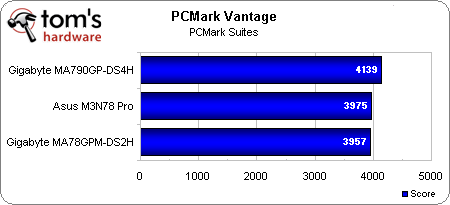

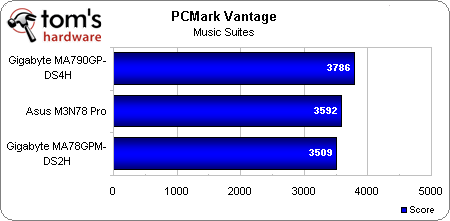

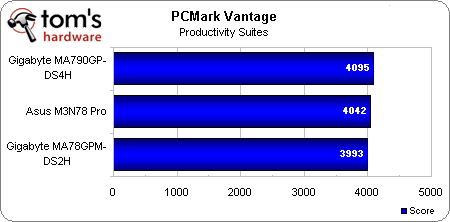
PCMark Vantage was the only system-level synthetic metric that’d cooperate with us. Sysmark 2007 — as much as we wanted to include it — just wouldn’t run reliably.
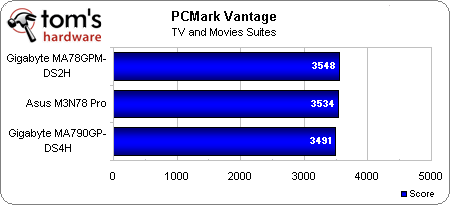
Nevertheless, the scores we pulled from PCMark shed some light on 790GX’s performance. The TV and Movies suite, for instance, consists largely of video playback and transcoding tasks, stressing processors and graphics cores almost equally. The fact that the 790GX scored comparably to the 780G and GeForce 8300 on systems with the same CPU suggest comparable playback acceleration — at least with MPEG-2, Blu-ray, and HD DVD content, the formats used in the test.
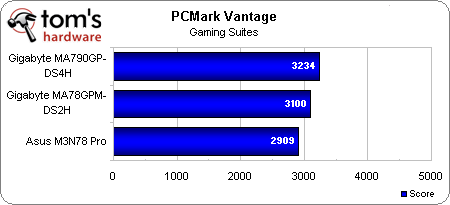
The Gaming suite yields scores in line with what we’d expect given a faster graphics core and the addition of side-port memory. Mainly, 790GX offers a measurable gain by virtue of its 200 MHz speed-up. Nvidia’s GeForce 8300 falls behind the 780G system, unable to keep up (until you add GeForce Boost, that is).
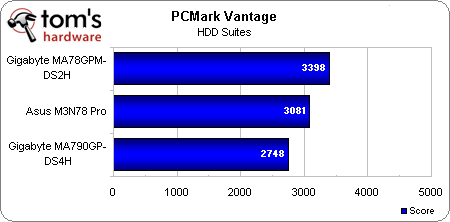
Most interesting, perhaps, was the HDD test, a series of eight Vista-based tasks that zero in exclusively on disk performance. For some reason, the 790GX machine trailed the 780G and GeForce 8300 platforms by a significant margin. Granted, Futuremark does admit the test is highly sensitive to system configuration and thus, subject to a margin of error. However, we still found those results highly suspect, even after a handful of retests. Now, here’s the amazing part. One of the apps that AMD provided with the 790GX beta driver pack was simply called DskPerf.exe — a performance program supporting SB600, SB700, and SB750 southbridges. Installing it, enabling advanced disk performance, involved a warning that running the driver increased the risk of data loss in the event of power loss. But it also boosted our Vantage HDD score from 2748 to 3606.
According to AMD, the driver activates advanced disk caching — something you can already do manually through Microsoft’s Device Manager. Intel and Nvidia are already using similar functionality in their drivers — this is simply AMD’s way to achieve the same performance. To turn it off, browse to the disk in question and un-check Enable advanced performance.
Get Tom's Hardware's best news and in-depth reviews, straight to your inbox.
-
kitsilencer Great review, and it's good to see that AMD is at last able to target more enthusiast markets competitively.Reply -
cangelini kitsilencerGreat review, and it's good to see that AMD is at last able to target more enthusiast markets competitively.Reply
Thanks for the feedback Kit. -
waffle911 So... why does a page 15 and 16 of this article exist if there is no page 15 or 16 to the article?Reply
Take a closer look. What happened? -
YYD PCMark seems Intel biased, please read this:Reply
http://arstechnica.com/reviews/hardware/atom-nano-review.ars/6
Please change this benchmark suite or check if PcMark Vantage is unbiased. -
cangelini waffle911So... why does a page 15 and 16 of this article exist if there is no page 15 or 16 to the article?Take a closer look. What happened?Reply
That was strange. Should be fixed now.
-
cangelini YYDPCMark seems Intel biased, please read this:http://arstechnica.com/reviews/har view.ars/6Please change this benchmark suite or check if PcMark Vantage is unbiased.Reply
Fortunately, with no Intel platforms tested, this should be a non-issue for the current situation ;-) In the future, you'll be seeing SYSmark, though. -
Seems past page 8 or something the links are corrupt.. can't fully read this article and getting error 404 - page not found.Reply
-
cangelini lacrits.. and now the article seems to be removed even from the main page!?!?!Reply
Alright, mystery solved. It's back up, sans the blank page. Thanks for pointing that out lacrits!
